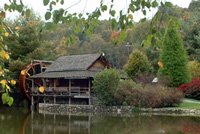 San Remo is called the Town of Flowers where beautiful roses, sweet-smelling carnations, and colorful begonias and camellias are cultivated. With exceptional climate, the heart of Italy’s floriculture region is in San Remo. Note the HAF fans (Blue) and CO2 injectors (Red). Image Source: Dr. Sandy Wilson, University of Florida.
San Remo is called the Town of Flowers where beautiful roses, sweet-smelling carnations, and colorful begonias and camellias are cultivated. With exceptional climate, the heart of Italy’s floriculture region is in San Remo. Note the HAF fans (Blue) and CO2 injectors (Red). Image Source: Dr. Sandy Wilson, University of Florida.(see note about exam at bottom of post).
INTRODUCTION
As we learned earlier in the semester, CO2 provides carbon to the growing plant when the physiological processes of photosynthesis and respiration achieve balance. Depending on the environmental control taking place in the greenhouse it can be beneficial both from a plant growth and economic standpoint to add supplemental CO2 to the greenhouse. After all, approximately 40% of the dry matter of most plant species consists of carbon.
Supplemental CO2 is most beneficial during periods when the greenhouse is not venting very regularly and supplemental light is being applied (or natural light is abundant). Conditions such as these are usually found during the winter production months. It is also important to remember that as transpiration rates increase the capacity for CO2 uptake increases for most plants with C3 photosynthesis.
LEARNING OBJECTIVES
- Explain the impacts of supplemental CO2 on plant growth.
- Discuss greenhouse environmental conditions that warrant supplemental CO2
- List several different methods of CO2 injection.
TERMS TO KNOW
photosynthesis
respiration
non-mineral nutrients
combustion
carbon deficiency
carbon dioxide injection
CO2 generator
timeclock
light sensor
kerosene
LP gas
natural gas
compensation point
READING ASSIGNMENT and ACTIVE LEARNING EXERCISES
1. Read Chapter 11 in your textbook. Carbon Dioxide Fertilization. pages 387-396.
2. Watch the following slide show reviewing the basics of this topic.
STUDY QUESTIONS and EXERCISES (Answer each of the following in complete sentences. In most cases 2-4 sentences will suffice).
- Explain why sufficient carbon dioxide levels are critical to plant growth and development.
- If 300 ppm of atmospheric CO2 is sufficient for most plant growth, why is it hypothesized that many plants respond positively to higher levels.
- Describe the CO2 compensation points. What is an average level at which greenhouse crops meet the CO2 compensation point?
- Explain some measurable benefits of CO2 injection into the greenhouse atmosphere using at least 3 different crop examples.
- Describe two different methods of carbon dioxide injection used in greenhouses today.
- At Eurofresh Farms (you have seen several videos) they inject CO2 during the day by running the boilers. The hot water generated during the combustion process is then stored and recirculated in the greenhouse during the night. Explain why they go to the additional effort to store the hot water.
- Why did using compressed CO2 as a source (which works effectively) fall out of favor and become replaced with injection methods that require combustion?
- What are some potential problems that can occur when using combustion as the source of CO2?
I realized last week that I needed to require that your presentations be in PowerPoint or Google Presentations. This is so that they can be shared online with the other online students. The more "traditional" presentation methods are really only an option for the seated class. Please complete your presentation using Google documents or PowerPoint and turn it in. If you need help with this please contact me. I am not grading on technical ability, just information presented.
The presentation does not need to cover every detail from the past four weeks of effort. It should cover the following things:
- the environmental production requirements for your plant
- how the greenhouse design you came up with is capable of meeting the plant's environmental needs
- how your greenhouse design meets any additional requirements for your business plan
NOTE ABOUT THE EXAM.
This exam will be in a familiar format. In order that I have time to grade it, I must receive it by Tuesday December 11th. I will e-mail it with instructions by the end of this week.










